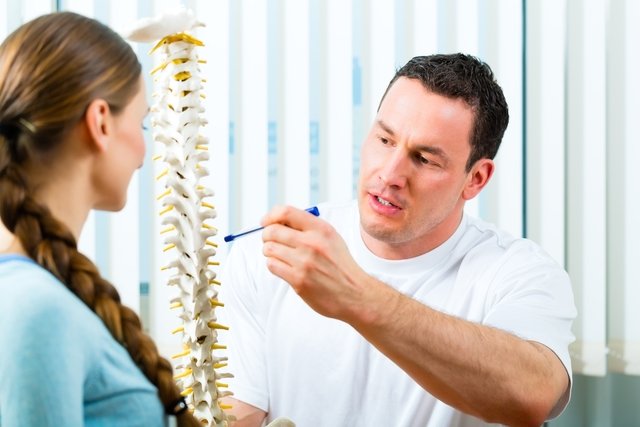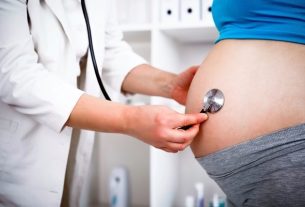The main spinal deviations are kyphosis, lordosis and scoliosis, which are not always serious and require treatment because in certain cases these deviations are mild and do not have major consequences for the individual.
The deviation in the spine may not present any symptoms or cause pain at certain times, and the doctor may recommend carrying out exercises to strengthen the local muscles, as well as physiotherapy sessions and, in some cases, surgery.
The spine has 33 vertebrae, 7 cervical, 12 thoracic, 5 lumbar, 5 sacral and 4 that form the coccyx. When viewed from the side, the healthy spine has smooth curves in the chest and lower back. When viewed from the back, the spine should be exactly in the middle of the back, but when the vertebrae are misaligned, scoliosis can occur. When viewed from the front, despite not being able to see the spine, it is possible to observe the changes that deviations in the spine cause: unevenness of the shoulders and/or hips.

1. Kyphosis
Kyphosis, also known as hyperkyphosis, occurs when the vertebrae of the thoracic spine curve backwards, forming a ‘hunchback’ appearance, with the shoulders slumping forward. This deviation is more common in older people, and is also closely related to osteoporosis in the spinal bones. Learn more about kyphosis.
Main symptoms: In addition to the appearance of a hunchback, kyphosis can have as its main symptoms pain in the upper back region, difficulty in keeping the body straight, and there may be a lot of pain when this position is forced, weakness or tingling in the arms and legs and difficulty breathing, in some cases.
How to deal with: To treat kyphosis, it is important to have guidance from an orthopedist and a physiotherapist, and it is normally recommended to carry out corrective exercises that strengthen the back muscles and stretch the pectoralis major and minor, in addition to better positioning the head. Clinical Pilates and RPG exercises (Global Postural Reeducation) are highly recommended, achieving excellent results.
In the most serious cases, when the baby is born with this change, or when the curve is very pronounced, the orthopedic doctor may indicate the need to perform surgery to help correct the spinal column, however, as a complementary form of this treatment, even The use of orthopedic braces and physiotherapy sessions for long periods is recommended.
2. Lordosis
Lordosis, or hyperlordosis, happens when the vertebrae of the lumbar or cervical spine curve inward. Thus, when it affects the cervical vertebrae, it is possible to notice the stretching of the neck, which is more forward, while in the case of lumbar lordosis, the pelvic region is positioned further back and the abdomen more forward, forming the appearance of ” upturned butt.”
Lordosis can be noticed since childhood and adolescence, and may be related to other changes such as a protruding abdomen, which is more globular, due to weakness of the abdominal muscles, and flat foot, although not all of these changes are always present at the same time.
Main symptoms: In addition to changes related to posture, it is possible to have pain in the lower back, decreased movement of the spine and a weaker abdomen. Learn how to recognize lordosis.
How to deal with: The most recommended treatment for lordosis is corrective exercises, it is important to strengthen the abdomen and stretch the lower back. Spinal manipulation can be performed by a physiotherapist, helping to correct the curvature. Exercises that can be performed on land, such as Pilates, with or without equipment, or in water, in the case of hydrotherapy or hydro Pilates, are a great option for improving overall posture and correcting the curvature of the spine. Role playing can also be part of the treatment.
3. Scoliosis
Scoliosis occurs when the vertebrae of the thoracic spine are laterally deviated, rotated, forming a C or S shape, which can affect the cervical, dorsal, and/or lumbar spine. This change can be serious when it affects babies and children, and surgery may be necessary.
Main symptoms: Due to the deviation of the thoracic spine, it is possible to observe some signs and symptoms such as one shoulder higher than the other, muscle pain, a feeling of fatigue in the back, one leg shorter than the other and one side of the hip higher than the other.
How to deal with: When the curvature is very severe, the doctor may recommend surgery to correct the deviation, with treatment complemented by physiotherapy, strengthening exercises, manipulation of the spinal joints, clinical Pilates, and/or RPG. In many cases it is possible to cure scoliosis, especially when it is mild and does not have serious consequences for the individual’s health. See more details on scoliosis treatment.
What causes spinal deviation
The cause of spinal deviations is not always clear, but they can occur due to postural changes or serious illnesses. These deviations can cause symptoms such as back pain, stiffness in the spine, and when the nerves are affected, tingling symptoms can appear in the arms, hands and fingers, or legs, feet and fingers.
Treatment is not always necessary, depending on the doctor’s discretion. Painkillers may be recommended to relieve symptoms, physiotherapy sessions, specific exercises to do at home, use of orthopedic braces, and in the most serious cases, surgery may be recommended, especially when there are major deviations in the spine since childhood.
When spinal deviation is dangerous
A small deviation in the spine is not serious and can only result in back pain at certain times, such as when standing or sitting for a long time. However, in the most serious cases, when the deviation in the spine is severe and can be seen with the naked eye, the individual may experience intense back pain, paresthesia, when the nerves are affected, which gives rise to symptoms such as muscle weakness, tingling or burning. These people are more likely to develop herniated discs and parrot beaks, presenting intense discomfort.

Sign up for our newsletter and stay up to date with exclusive news
that can transform your routine!
Warning: Undefined array key "title" in /home/storelat/public_html/wp-content/plugins/link-whisper-premium/templates/frontend/related-posts.php on line 12
Warning: Undefined array key "title_tag" in /home/storelat/public_html/wp-content/plugins/link-whisper-premium/templates/frontend/related-posts.php on line 13



